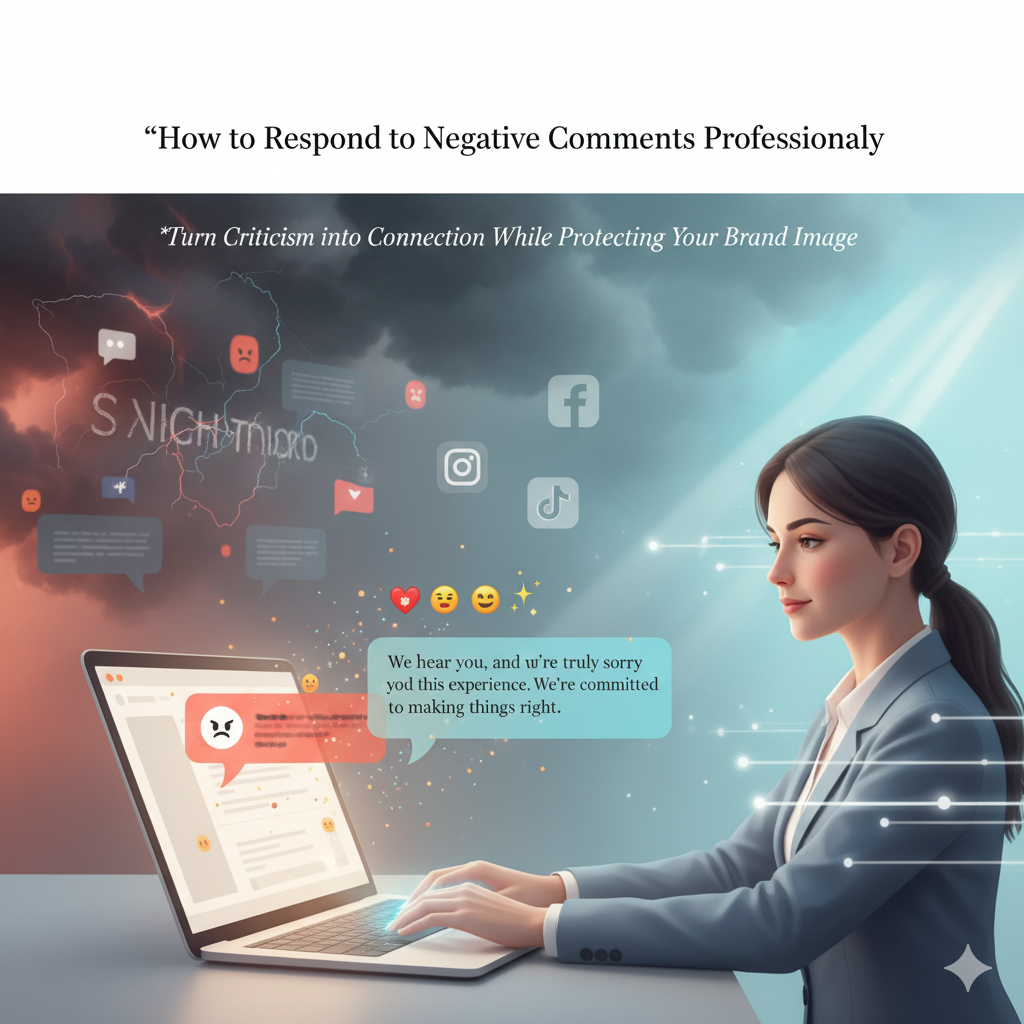
How to Respond to Negative Comments Professionally While Protecting Your Brand Image
Introduction: When Negativity Meets Professionalism
In today’s social media era, no brand is immune to negative comments. Whether it’s a dissatisfied customer, a misunderstanding, or even a troll, how you respond can make or break your brand’s reputation. Instead of ignoring or reacting emotionally, brands that handle criticism with professionalism often gain respect, loyalty, and even new followers.
This article explores how to turn negative comments into opportunities to strengthen trust, showcase authenticity, and build long-term relationships with your audience.
1. Understand the Source of the Comment
Before you type a single word, take a moment to analyze where the comment comes from:
- Constructive feedback: Usually includes specific issues and offers suggestions. These comments are valuable for improving your service.
- Emotional reactions: Often come from frustration or misunderstanding. A calm, empathetic reply can diffuse tension.
- Trolling or spam: Meant to provoke. Avoid engaging too deeply; a short, professional response or even silence works best.
💡 Tip: Train your social media team to identify comment types quickly and respond accordingly.
2. Respond Promptly — But Calmly
Timing is crucial in online communication. A delayed response may make your brand seem careless, but an impulsive reply could make things worse.
- Acknowledge the issue within a few hours.
- Thank the user for sharing feedback.
- Take the conversation to private messages if it requires detailed resolution.
Example:
“Thank you for letting us know about your experience. We truly value your feedback and would love to discuss this further in DM to find the best solution for you.”
This approach shows you care without fueling public confrontation.
3. Keep a Professional and Empathetic Tone
Empathy is your strongest weapon in customer communication. Show that you understand their frustration. Avoid defensiveness or sarcasm, no matter how unfair the comment seems.
Try this formula: Acknowledge → Apologize (if applicable) → Offer a solution.
Example:
“We’re sorry to hear you had this issue. Our goal is always to deliver the best experience, and your feedback helps us improve. Could you please share more details so we can fix this?”
This not only calms the situation but also signals transparency and professionalism to other followers watching the conversation.
4. Move the Discussion Offline When Needed
Some issues require privacy, especially when they involve personal data, billing, or complex problems. In such cases, gently move the conversation to direct messages, email, or customer support channels.
Example:
“We’d love to assist you directly. Please send us a message with your order number so we can resolve this as soon as possible.”
This keeps the public feed clean and shows that you take the matter seriously.
5. Know When Not to Engage
Not every negative comment deserves a response. Trolls and bots thrive on attention. If a message is purely provocative or violates your community guidelines, you can:
- Hide or delete it (if it’s offensive).
- Report spam or harassment.
- Maintain a “no-drama” policy to protect the brand’s tone.
Being selective in your engagement keeps your online space healthy and aligned with your brand values.
6. Turn Negative Feedback into Valuable Insights
Every complaint reveals something: a service flaw, a communication gap, or an expectation mismatch. Instead of viewing criticism as a threat, treat it as free market research.
You can:
- Track recurring themes in complaints.
- Update FAQs or improve processes based on feedback.
- Publicly share improvements to show responsiveness.
Example:
“We heard your feedback about delivery delays and have added new tracking features to keep you updated in real time.”
This transparency not only repairs trust but also enhances brand credibility.
7. Celebrate the Positive Outcomes
When a customer changes their opinion after your good handling, highlight that success. A once-upset customer who becomes a supporter is powerful social proof.
Example:
“We’re glad we could resolve your issue, and we truly appreciate your understanding!”
Turning negative interactions into positive stories strengthens your brand’s authenticity and shows others that you genuinely care.
Conclusion: Professionalism Always Wins
In social media management, how you handle negativity reflects your brand’s maturity and values. A well-crafted, empathetic response can transform critics into advocates.
Remember
Don’t react emotionally.
- Respond with empathy and professionalism.
- Use feedback as a tool for growth.
By mastering the art of responding to negative comments, your brand won’t just survive online criticism — it will thrive from it.
📌 Visit Us: STABLESMP.COM
Suggested Keywords:
- Stable SMP
- social media panel
- SMM services
- social media marketing
- SMM reseller panel
- buy social media services
- social media growth
- increase social media engagement
- social media management
- affordable SMM panel
Date:04/11/2025